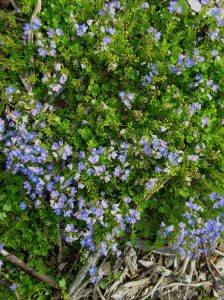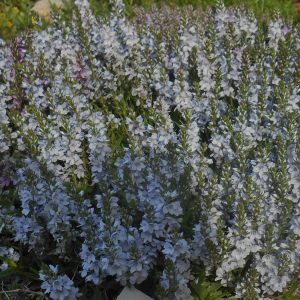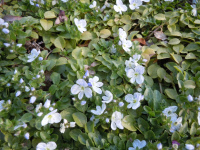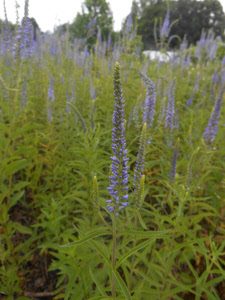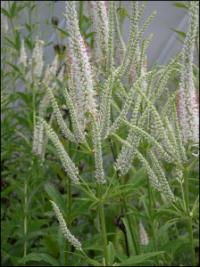Our Plants
Showing 601–608 of 616 results
-
Veronica gentianoides Gentian speedwell Z. 4-9
Erect spikes of pale blue flowers sprouting above clumps of basal foliage in late spring/early summer.
Erect spikes of pale blue flowers sprouting above clumps of basal foliage in late spring/early summer.
Can not ship to: Illinois
Size: 18" x 12"
Care: sun to part shade in moist well-drained soil
Native: eastern Europe
Wildlife Value: attracts butterflies
Awards: England's Royal Horticultural Society Award of Merit.According to Christian tradition, as Jesus carried the cross to Calvary, a woman wiped his face with her handkerchief, leaving the imprint of the features of his face, the vera iconica, meaning “true likeness.” When the Catholic Church canonized the woman, the Church gave her the name Saint Veronica. Medieval gardeners named the plant after her due to the perceived likeness of the flower to her handkerchief. Introduced to European gardens by 1784.
-
Veronica liwanensis Turkish speedwell Z 4-8
Tiny true blue saucers smother the ground
OUT OF STOCK
Tiny true blue saucers smother the ground in May & June – groundcover, front of border or rock garden plant.
Size: 1” x 18” spreader over time
Care: sun to part shade in moist well-drained to well-drained soil
Native: NE Anatolia, Caucasus
Wildlife Value: attracts butterflies
Awards: 1997 Plant Select Winner.Collected before 1849.
-
Veronica officinalis Common speedwell Z 3-7
Mat-forming perennial with spikes of blue flowers with darker blue stripes on the petals, May-August
OUT OF STOCK
Mat-forming perennial with spikes of blue flowers with darker blue stripes on the petals, May-August
Size: 4-12” x 6”
Care: sun in dry, well-drained soil
Native: Europe and Asia
Wildlife Value: attracts beesUsed in European traditional medicine as a cough remedy and tonic as well as a salve. Used for centuries as a cure-all medicinal as long ago as ancient Rome. Grown at America’s 1st botanic garden, Elgin Botanic Garden 1811.
-
Veronica porphyriana Bird’s-eye speedwell Z 3-8
June – September (WOW!) short blue-purple, more blue than purple, spikes of compact flowers bloom on short, slowly creeping mat of sword-shaped foliage that suppresses weeds.
June – September (WOW!) short blue-purple, more blue than purple, spikes of compact flowers bloom on short, slowly creeping mat of sword-shaped foliage that suppresses weeds.
Size: 6-8” x 12”
Care: sun to part shade in well-drained soil
Native: Siberia, Mongolia & Kazakhstan
Wildlife Value: attracts pollinators. Drought tolerant; deer and rabbit resistantAccording to Christian tradition, as Jesus carried the cross to Calvary, a woman wiped his face with her handkerchief, leaving the imprint of the features of his face, the vera iconica, meaning “true likeness.” When the Catholic Church canonized the woman, the Church gave her the name Saint Veronica. Medieval gardeners named a different Veronica after her due to the perceived likeness of the flower to her handkerchief. Collected by 1950 Russian botanist Nikolái Pávlov (1893-1971) described and named this in Vestn. Akad. Nauk Kazakhsk. S.S.R v.4 p. 92 (Academy of Sciences of the Kazakh SSR) in 1951. Kazakh is the name of the language of people of Central Asia inhabiting mainly Kazakhstan which became independent of Russia in 1991.
-
Veronica prostrata syn. V. rupestris Sprawling speedwell, Harebell speedwelll Z 4-8
From midspring to midsummer short blue spikes above prostrate foliage.
OUT OF STOCK
From midspring to midsummer short blue spikes above prostrate foliage.
Size: 6” x 18”spreads
Care: sun to part shade in moist well-drained soil.
Native: Europe
Wildlife Value: Deer and rabbit resistant.
Awards: Royal Horticultural Society Award of Garden Merit.In gardens since at least 1753 (Linnaeus). Bloomed for 4 or more months in rock garden at Edinburgh Botanic Garden (The Garden, Jan. 1876.)
-
Veronica repens Creeping speedwell Z 5-9
Palest of blue blooms in spring
OUT OF STOCK
Palest of blue blooms in spring on this low, creeping groundcover.
Size: 2” x 8-12”
Care: full sun to part shade in moist to moist well-drained soil
Native: CorsicaAccording to Christian tradition, as Jesus carried the cross to Calvary a woman wiped his face with her handkerchief, leaving the imprint of Christ’s features, the vera iconica, meaning “the true likeness.” When the Catholic Church canonized the woman the Church named her Saint Veronica. Medieval gardeners named the plant after her due to a perceived likeness of the flower to her handkerchief. This species collected by 1800. According to William Robinson, father of the mixed perennial garden, Veronica repens “clothes the soil with a soft carpet of bright green foliage, covered in spring with pale bluish flowers.”
-
Veronica spicata Speedwell Z 4-8
Erect crowd of bluish-purple star-shaped flowers cover terminal spikes all summer growing high above basil foliage. If deadheaded blooms all summer.
Erect crowd of bluish-purple star-shaped flowers cover terminal spikes all summer growing high above basil foliage. If deadheaded blooms all summer.
Size: 24" x 18-24"
Care: Sun in well-drained soil
Native: Hilly pastures in Europe and North Asia
Wildlife Value: attracts butterfliesAccording to Christian tradition, as Jesus carried the cross to Calvary a woman wiped his face with her handkerchief, leaving the imprint of Christ’s features, the vera iconica, meaning “the true likeness.” When the Catholic Church canonized the woman, the Church gave her the name Saint Veronica. Medieval gardeners named this plant after her due to a perceived likeness of the flower to her handkerchief. Veronicas have been in cultivation since at least Medieval times. Europeans made tea from V. spicata. This was planted in a symmetrical garden at Versailles.
-
Veronicastrum virginianum, Culver’s root Z 4-9
Tall, graceful ivory spires made of multitudes of small tubes crowd along the stem, arranged like a candelabra. This flowers from early to mid-summer.
Tall, graceful ivory spires made of multitudes of small tubes crowd along the stem, arranged like a candelabra. This flowers from early to mid-summer.
Size: 4' x 18"
Care: full sun to part shade in moist soil
Native: From Canada to Texas, Wisconsin native
Wildlife Value: Numerous bee species, including the Rusty patched Bumble Bee, wasps, and butterflies collect pollen and drink the nectar.Used by American Indians as a laxative and to induce vomiting and clean blood. Cherokee cured typhus and inactive livers with Culver’s root. Seneca Indians used the root in their ceremonies. Sioux also used this to stimulate the liver. They also burned the root for the smoke to purify those who had contact with a dead family member. 1st collected by Rev. John Banister (1649-1692) who moved to colonial Virginia in 1678. A gunman mistakenly shot and killed him while he collected plants. Colonial Puritan Cotton Mather unsuccessfully attempted to use this plant to cure his daughter’s tuberculosis in 1716. Colonial nurseryman John Bartram (1699-177) recorded medicinal uses saying, “One Handful of the Roots of this Plant, boiled in a Pint of Milk, and drank, is used by the back Inhabitants for a powerful Vomit.” Pressed specimen in Emily Dickinson’s herbarium.


